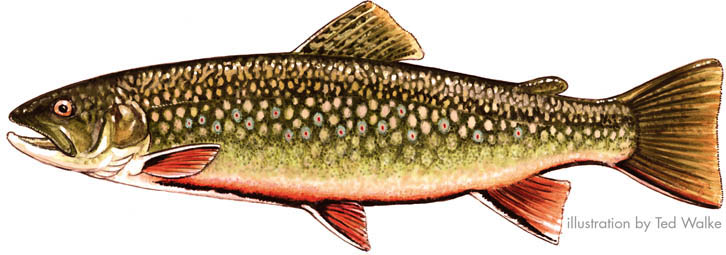The Smoky Mountain Brook trout sport wavy lines, on its dark, olive-green back – it’s their most recognized characteristic. It’s also a literal camouflage in that the brook takes on the appearance of flowing water which allows the brook trout hide from predators that lurk above.You’ll also notice its pale yellow spots and a few small red spots if you’re lucky enough to catch one.
A main giveaway that you’ve caught a Brook trout is the white edging along its fins. However, they can be a definite disadvantage when it comes to keeping hidden from predators.
Brook trout swim efficiently in water as shallow as the depth of its body due to its length. They have the ability to maneuver around and through a variety of obstacles, which is an asset in capturing food no matter how deep the water.
You’ll find brook trout in colder, clearer streams. They’re also seen as the most cold tolerant of all trout found in the Smokies.
Brook-trout populations reach as far south as Georgia along the Great Smoky Mountain chain, but have been steadily declining since at least 1900 and probably earlier. And not only is it due to what is the most common thought – the more adaptable rainbow trout. Overfishing, as well as logging, was prevalent and destroyed many of lower elevation habitats and the more accessible areas of highland streams that the brook had come to rely on.
Logging was essentially eliminated with the establishment of the Great Smoky Mountains National Park in 1936. Still, brook trout populations have continued to steadily decrease in the area. Accordingly, rainbow trout that were first introduced into the regional streams in 1910 have slowly displaced the remaining brook trout, thus sending them higher and higher into the area’s headwater streams. These headwater areas are thought to be the brook trout’s last refuge among the Great Smoky Mountains as the upstream movement of the rainbow may be finally limited by physical barriers such as waterfalls or other obstacles created by park employees on the brook trout’s behalf.
The brook trout is at its best in waters with a temperature range of 40 to 68 degrees. Still, brook trout feed at temperatures as low as 34 degrees.
Somewhere between 72 and 77 degrees is where you’ll find a brook’s tolerance. Usually this is reached at some point during the summer months. There are of course exceptions during this time, like to avoid a predator or hunt. During this time brook may navigate into warmer waters but only for a short time.
Brook trout generally have the shortest life span of the various trout species, usually living on average 4 years. Their overall growth is dependent on such natural factors as water temperature, habitat, and competition from other fish. The brook will rarely weigh more than three pounds, even in productive waters, by the end of their third year of life.
The catch-and-release process seems to provide the brook trout with a lot of stress at spawning time. It’s widely thought that the brook should be left unmolested during this season, even though some brook trout waters permit year round fishing.
